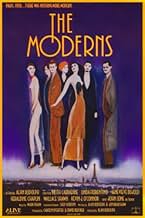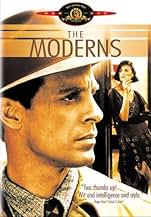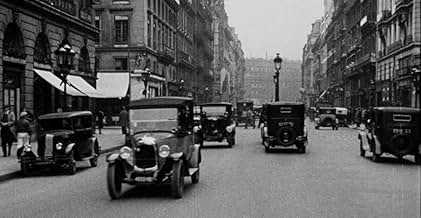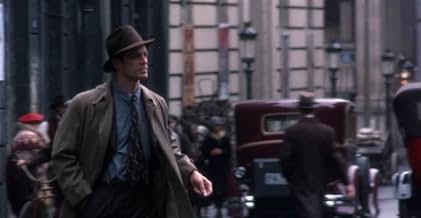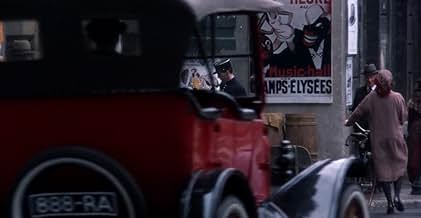NOTE IMDb
6,6/10
2,1 k
MA NOTE
Ajouter une intrigue dans votre langueA struggling artist is hired to forge paintings, causing him to cross paths with his ex-wife and her powerful new husband.A struggling artist is hired to forge paintings, causing him to cross paths with his ex-wife and her powerful new husband.A struggling artist is hired to forge paintings, causing him to cross paths with his ex-wife and her powerful new husband.
- Réalisation
- Scénario
- Casting principal
- Récompenses
- 2 victoires et 5 nominations au total
Geneviève Bujold
- Libby Valentin
- (as Genevieve Bujold)
Charlélie Couture
- L'Evidence
- (as Charlelie Couture)
Véronique Bellegarde
- Laurette
- (as Veronique Bellegarde)
Avis à la une
*****SPOILER ALERT!!!*****
Alan Rudolph's "The Moderns" is a wonderful, funny and twisted film set in 1920's Paris, France. The front burner story is a triangle between Nick, his runaway wife and a cold as ice businessman that wants to obtain a higher social status. Nick(Keith Carradine)and Rachel(Linda Fiorentino)were married years ago and she bails out of the marriage. Years later, she shows up on the arms of Bertram Stone (John Lone). While he deals with her reappearance, he is also talked into making art forgeries by a rather shady behaving gallery owner, Valentin(Genevieve Bujold), as a favor for the wealthy Nathalie De Ville(Geraldine Chaplin). His friend, Oiseau (Wallace Shawn)constantly tells Nick that they should head to a new town called Hollywood to seek their fortune and Ernest Hemingway (Kevin J. O'Connor)wanders around in a state of alcoholic cynicism and making quirky observations.
The story, like the period in which the action takes place, is surreal. One scene has one of the dead characters rise from the grave like Houdini, strait-jack, chains and all. The relationship between Nick and Rachel is the heart of the story: Nick doesn't want to trust Rachel because of what she did, but all of his actions throughout the film are a result of Rachel. When he paints the forgeries, he thinks of Rachel's beauty and puts his feelings on canvas. He loves her, but is fighting with the possibility that if he opens his heart to her again, she will break it again. You can see this conflict when he slaps her in front of Stone, yet immediately becomes apologetic. Should he love her, or should he just back off? He clearly does when they share a sexual romp on the bathroom floor while her husband is downstairs.
The entire cast is great, but the best performance comes from O'Connor, who I think is one of the most underrated actors around.
This is a great movie to have if you feel like having a Paris night movie marathon, or just to have fun.
Alan Rudolph's "The Moderns" is a wonderful, funny and twisted film set in 1920's Paris, France. The front burner story is a triangle between Nick, his runaway wife and a cold as ice businessman that wants to obtain a higher social status. Nick(Keith Carradine)and Rachel(Linda Fiorentino)were married years ago and she bails out of the marriage. Years later, she shows up on the arms of Bertram Stone (John Lone). While he deals with her reappearance, he is also talked into making art forgeries by a rather shady behaving gallery owner, Valentin(Genevieve Bujold), as a favor for the wealthy Nathalie De Ville(Geraldine Chaplin). His friend, Oiseau (Wallace Shawn)constantly tells Nick that they should head to a new town called Hollywood to seek their fortune and Ernest Hemingway (Kevin J. O'Connor)wanders around in a state of alcoholic cynicism and making quirky observations.
The story, like the period in which the action takes place, is surreal. One scene has one of the dead characters rise from the grave like Houdini, strait-jack, chains and all. The relationship between Nick and Rachel is the heart of the story: Nick doesn't want to trust Rachel because of what she did, but all of his actions throughout the film are a result of Rachel. When he paints the forgeries, he thinks of Rachel's beauty and puts his feelings on canvas. He loves her, but is fighting with the possibility that if he opens his heart to her again, she will break it again. You can see this conflict when he slaps her in front of Stone, yet immediately becomes apologetic. Should he love her, or should he just back off? He clearly does when they share a sexual romp on the bathroom floor while her husband is downstairs.
The entire cast is great, but the best performance comes from O'Connor, who I think is one of the most underrated actors around.
This is a great movie to have if you feel like having a Paris night movie marathon, or just to have fun.
Rudolph sets an interesting atmosphere in this film about artists in Paris between the wars. Most of the scenes are borrowed from Hemingway's "A Movable Feast," and the dialog liberally pokes fun of the author. Some characters play better than others - Wallace Shawn's Oiseau is memorable, as is John Lone's Creepy, enigmatic part. I enjoy Carradine's artist character - though I understand that some people are rubbed the wrong way by his performance. Linda Fiorentino is somewhat annoying in her part, as is Genevieve Bujold. Still, as other comments note, the soundtrack is really quite impressive - and worth having on its own. Overall, if you like Rudolph's films, and you want to see an interesting take on some of Hemingway's autobiographical ramblings, this is a fun one to watch. This is a film that I first went to see by accident, but liked more an more as time went on - personally I put it in a class with "Diva" for atmosphere - some characters work, and others don't, and you either like the movie or you hate it. I, for one, like it.
Alan Rudolph does not make movies for everyone to see. His movies seem like personal projects that interest him at the time. Some of his movies I haven't been able to get involved in (Trixie, Mortal Thoughts, Afterglow) but with The Moderns, I was pulled in quickly. The story focuses on Keith Carradine's ex-patriot Nick Hart, a painter who has the ability to duplicate famous works of art with his brush. He's hired to create forgeries by Mademoiselle de Ville (Geraldine Chaplin).
But the story doesn't stop there. There are other ex-patriots around, including young Ernest Hemingway, comically portrayed by Kevin J. O'Connor; who is constantly drinking, philosophizing and pursuing women. It's not a flattering look at Hemingway, but somehow it adds to the whole ambience of the film and seems to ring true. And then there is Linda Fiorentino, a former lover of Nick's, and her husband, the rich and icy Bertram Stone (John Lone). The characters are odd and quirky, the story is uneven at times, and meanders a bit, but it is never boring. This movie has such style and depth that it pulls the viewer in, like we're trying to see the work that is under the painted canvas. That's what this movie is about -- the greater depth of art. What is art and what is crap? What is love and what is hate? What is real and what is illusion? As a director, Alan Rudolph pulls us along cleverly, with a hint of intrigue, the dichotomy of Nick's love and Hemingway's carousing, a taste of passion and the beauty of art. Then there are the characters who are well-layered works of art themselves. Maybe this movie isn't a masterpiece, but it leaves us chipping away at the paint trying to see what treasure is underneath. It's a movie to be enjoyed
But the story doesn't stop there. There are other ex-patriots around, including young Ernest Hemingway, comically portrayed by Kevin J. O'Connor; who is constantly drinking, philosophizing and pursuing women. It's not a flattering look at Hemingway, but somehow it adds to the whole ambience of the film and seems to ring true. And then there is Linda Fiorentino, a former lover of Nick's, and her husband, the rich and icy Bertram Stone (John Lone). The characters are odd and quirky, the story is uneven at times, and meanders a bit, but it is never boring. This movie has such style and depth that it pulls the viewer in, like we're trying to see the work that is under the painted canvas. That's what this movie is about -- the greater depth of art. What is art and what is crap? What is love and what is hate? What is real and what is illusion? As a director, Alan Rudolph pulls us along cleverly, with a hint of intrigue, the dichotomy of Nick's love and Hemingway's carousing, a taste of passion and the beauty of art. Then there are the characters who are well-layered works of art themselves. Maybe this movie isn't a masterpiece, but it leaves us chipping away at the paint trying to see what treasure is underneath. It's a movie to be enjoyed
This may not be everyone's cup of tea, but it has a genuine, unpretentious charm to it that I found appealing.
Alan Rudolph made this delightful little ode to lies, trickery and delusion on a shoestring budget. The story of a failed painter down on his luck in Paris in the 1920's who accepts a comission to forge a famous impressionist painting. The film questions what is real versus what is perceived or subjective. In a series of criss-crossing subplots and seemingly random encounters Rudolph has fun playing with the trickery of film to made some sly points about the art forms we hold dear.
The film was shot in Montreal, Canada, standing in for Paris and New York in the 1920's, with French-Canadian actors playing Parisians... The plot twists include a millionaire art collector publicly slashing a priceless painting, thinking it a forgery, while the fake painting is sent to hang in a New York museum. A Dadaist poet fakes his own death in order to attend his funeral to hear the things people will say about him. Same character, named L'Oiseau is actually an American ex-patriate named Fagelman! In a toungue-in-cheek hommage to people's perception of the period, Rudolph has Papa Hemmingway hanging-out in all the cafe's and at all the parties... He is seemingly everywhere, sipping scotch and mouthing tough-guy cliches...
But the viewer must beware of what he is watching. In a scene where Bujold's character rides in a taxi with Carradine's we are treated to lovely rear projection shots through the cab's back window of impressionist paintings of Paris at night! In another dimly lit cafe scene Rudolph chose to end the scene by panning away from the action to the bar where among the extras in period costume, two punk rockers are watching a hockey game on t.v.
Alan Rudolph made this delightful little ode to lies, trickery and delusion on a shoestring budget. The story of a failed painter down on his luck in Paris in the 1920's who accepts a comission to forge a famous impressionist painting. The film questions what is real versus what is perceived or subjective. In a series of criss-crossing subplots and seemingly random encounters Rudolph has fun playing with the trickery of film to made some sly points about the art forms we hold dear.
The film was shot in Montreal, Canada, standing in for Paris and New York in the 1920's, with French-Canadian actors playing Parisians... The plot twists include a millionaire art collector publicly slashing a priceless painting, thinking it a forgery, while the fake painting is sent to hang in a New York museum. A Dadaist poet fakes his own death in order to attend his funeral to hear the things people will say about him. Same character, named L'Oiseau is actually an American ex-patriate named Fagelman! In a toungue-in-cheek hommage to people's perception of the period, Rudolph has Papa Hemmingway hanging-out in all the cafe's and at all the parties... He is seemingly everywhere, sipping scotch and mouthing tough-guy cliches...
But the viewer must beware of what he is watching. In a scene where Bujold's character rides in a taxi with Carradine's we are treated to lovely rear projection shots through the cab's back window of impressionist paintings of Paris at night! In another dimly lit cafe scene Rudolph chose to end the scene by panning away from the action to the bar where among the extras in period costume, two punk rockers are watching a hockey game on t.v.
I must admit Alan Rudolph's work is hard to either greatly admire or sternly criticize. He has become one of these directors, like David Cronenberg or Paul Verhooven, that some love and some despise. But, the reality is it is hard to know where such directors stand. I must say that my feeling that Rudolph's films were too much like his mentor Robert Altman's has been changed upon seeing "The Moderns." While I am a huge fan of Altman, it has been hard for me too admire directors that seem too merely imitate him. But, this film is much more surreal than anything that Altman has done, especially in recent years. The film also establishes a clear mood and setting. Rudolph also selects very solid shots throughout the film. If there has been one disadvantage of the cinema medium over stage, it is that the audience can not see an actor's immediate response to a given situation because the focus is on another character. But, here Rudolph lets you inside virtually each of the characters. The cast is also solid. Keith Carradine is at his best. It is a shame that he now apparently has to go to Iceland to find cinematic roles, but if one thinks Jeff Bridges is an underrated actor there is proof- at least in this film--- that Carradine has been overlooked even more. I also think Wallace Shawn is great here, which is amazing considering that I am NOT a fan of the film "My Dinner with Andre." And, lastly Mark Isham's score is brilliant in this film. It may not be a film for all tastes, and because of its simplistic nature it is understandable why this film gets lost in the shuffle when it comes to discussions about great films from the 80s. Nevertheless, I think it is a remarkable film if not for anything else it does prove that an American can make a great movie set in Paris, which is not a musical, even if it was (as this film was) shot in Montreal!
Le saviez-vous
- AnecdotesIsabella Rossellini screen-tested to play Nathalie DeVille, but lost to Geraldine Chaplin.
Meilleurs choix
Connectez-vous pour évaluer et suivre la liste de favoris afin de recevoir des recommandations personnalisées
- How long is The Moderns?Alimenté par Alexa
Détails
Box-office
- Budget
- 3 500 000 $US (estimé)
- Montant brut aux États-Unis et au Canada
- 2 011 497 $US
- Week-end de sortie aux États-Unis et au Canada
- 20 283 $US
- 17 avr. 1988
- Montant brut mondial
- 2 011 497 $US
- Durée2 heures 6 minutes
- Couleur
- Mixage
- Rapport de forme
- 1.85 : 1
Contribuer à cette page
Suggérer une modification ou ajouter du contenu manquant

Lacune principale
By what name was Les modernes (1988) officially released in India in English?
Répondre




